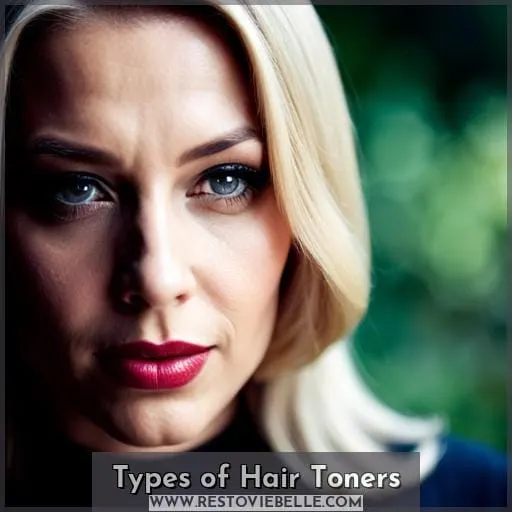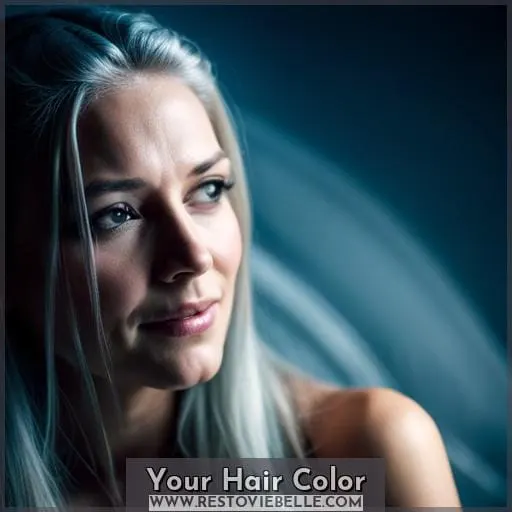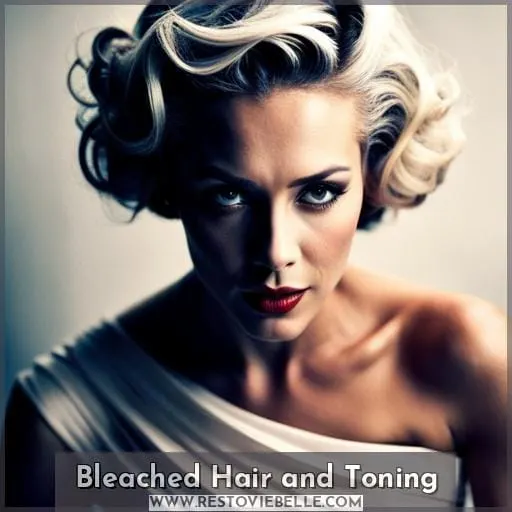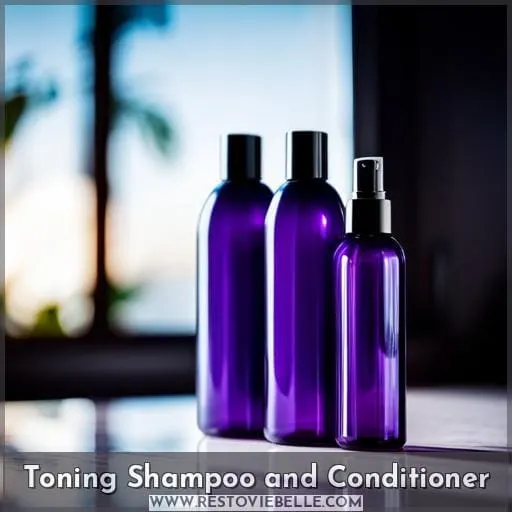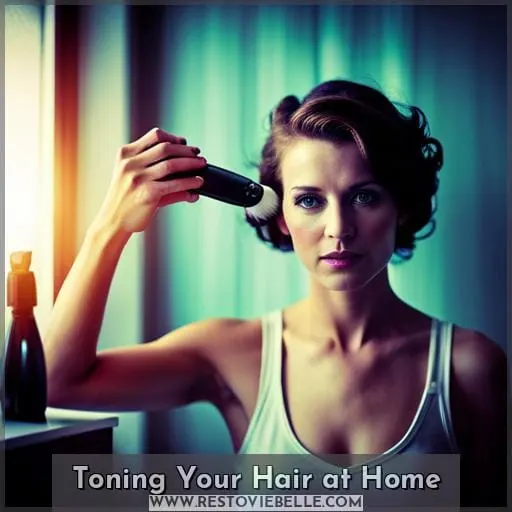This site is supported by our readers. We may earn a commission, at no cost to you, if you purchase through links.
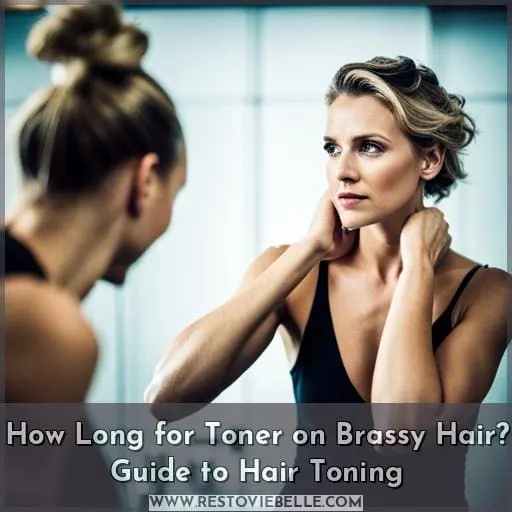 Do you want to learn how long you should leave toner on brassy hair? Toning hair can be a tricky process, and it’s easy to make mistakes that damage your strands. To avoid this, get educated on the right amount of time for leaving toner in your hair.
Do you want to learn how long you should leave toner on brassy hair? Toning hair can be a tricky process, and it’s easy to make mistakes that damage your strands. To avoid this, get educated on the right amount of time for leaving toner in your hair.
We’ll cover what types of products are available and how they work. Factors affecting the recommended processing times like strand test results and bleached locks will also be discussed.
Get ready – we’re diving into all things related to achieving perfect tresses with the proper use of toners!
Table Of Contents
- Key Takeaways
- How Long Should You Leave Toner in Your Hair?
- What is Hair Toner and How Does It Work?
- Types of Hair Toners
- Your Hair Color
- Bleached Hair and Toning
- Your Hair Condition
- Hair Strand Test
- Toning Shampoo and Conditioner
- Hair Gloss and Its Benefits
- What Happens if You Leave the Toner on for Too Long?
- Toning Your Hair at Home
- Want to Learn More About Hair Coloring?
- Frequently Asked Questions (FAQs)
- Conclusion
Key Takeaways
- Factors to consider when toning brassy hair: type of toner, starting color, and hair health.
- Recommended processing times: semi-permanent toners (1-3 minutes), demi-permanent glosses (5-15 minutes), permanent toners (up to 45 minutes).
- Perform a strand test and assess hair health before toning brassy hair.
- Use UV protectant after toning to maintain vibrancy.
How Long Should You Leave Toner in Your Hair?
When considering toning your hair, there are a few factors to take into account. These include the type of toner being used and the starting color and health of your hair. Knowing how long to leave toner on brassy hair is particularly important for achieving desired results without damaging or over-toning it.
Generally, recommended processing times range from 15 minutes up to 45 minutes depending on brand instructions as well as individual characteristics such as brassy/warmness levels in lightened or bleached strands, porosity and condition of locks etc.
Factors to Consider
When considering toner application, it’s important to take into account the starting color and health of your hair, as well as the type of product you’re using. Semi-permanent toners, such as shampoos or conditioners, should be left in for 1-3 minutes, while demi-permanent glosses require 5-15 minutes.
Permanent toning can last up to 45 minutes, depending on how much brassy warmth needs neutralizing. Performing a strand test and assessing hair health are also recommended before proceeding with treatment time.
A UV protectant is necessary after applying any kind of toner to maintain vibrancy and prevent fading over time. Swimming pools should be avoided too! Toning frequency depends on the type used. Toning shampoo should be used once weekly, gloss every 4-6 weeks, and permanent toner every 6-8 weeks.
However, keep an eye out for signs that the scalp or strands need a break from regular treatments due to excessive damage.
Recommended Toning Times
You should take into account the type of toner being used, your hair’s starting color and health, as well as any instructions on the packaging when deciding how long to tone your hair.
Semi-permanent toners, such as shampoos, can be left on for 1-3 minutes, while demi-permanent glosses require 5-15 minutes. Permanent toners may need up to 45 minutes, and brassy dark hair around 20 minutes.
Brassy medium or light tones should be done for 10-15 minutes or 5-10 minutes, respectively.
Wella T18 has a processing time of 30 minutes max, which can turn yellow/golden hues into an ash blonde shade.
UV protection afterwards helps maintain that beautiful hue, plus moisturizing shampoo and conditioner to keep it healthy and shiny too!
What is Hair Toner and How Does It Work?
Hair toner is a product that can give your hair a boost of color, neutralize undertones, and add shine – so it’s worth getting to know how it works. Toner deposits pigment into the hair to counteract unwanted color, such as yellow or golden tones for blondes and ash brown shades for brunettes.
It also maximizes existing hair color while enhancing its vibrancy and adding extra shine.
There are three types of toners: permanent, demi-permanent, and semi-permanent toners. They vary in application time from 1-3 minutes up to 45 minutes, respectively, depending on the desired result. A strand test should be performed prior to applying any type of toner. This will help determine the appropriate processing times for each individual’s needs based on their starting shade/undertone balance, as well as overall condition/porosity level health before committing fully to the treatment process itself.
UV protection should always be used after coloring with a deposit-only formula like Wella T18. Post-conditioning treatments become even more essential when using strong developer formulas like 40 volumes, which can cause damage if left too long or misapplied.
Types of Hair Toners
Ready to take your hair color up a notch? Toning is an effective way to enhance the look of dyed or natural hair. Semi-permanent toners, such as shampoos and conditioners, are applied for 1-3 minutes, while demi-permanent toner glosses require 5-15 minutes.
For maximum results and significant color correction, permanent toning takes between 15 and 45 minutes.
Semi-permanent Toner
Semi-permanent toners, such as toning shampoos and color-depositing conditioners, are a breeze to apply – usually taking no more than a few minutes.
Toning frequency should depend on your hair’s condition. For brassy or warm hair, use semi-permanent toner every week or two weeks while avoiding leaving it on too long. Ammonia-based demi-permanent gloss can provide longer-lasting results but requires UV protectant following application to maximize the longevity of tone.
To avoid damage, always read instructions carefully before applying any type of toner and follow up with deep conditioning treatments after rinsing out the product!
Demi-permanent Toner
Demi-permanent toners, such as gloss, can be applied for 5-15 minutes to enhance and refine the color of your hair.
To maintain the desired look, it’s recommended that you use a UV protectant after treatment and avoid excessive swimming in pools or using heat tools. Before application, it’s important to perform a strand test to determine how long the toner should remain on your hair, according to professional advice.
Be aware of developer dangers when mixing with some types of permanent toners. Seek help from an experienced hairdresser if you’re unsure about this process! It’s also essential that you wash your hair immediately with shampoo formulated for color-treated locks once finished before applying conditioner.
Permanent Toner
Permanent toner can provide dramatic color changes that last, so you’ll have to be extra careful when applying it. Mix the permanent products with a developer mix and follow up with a UV protectant for best results.
Perform a strand test before application to assess the desired shade and hair health. Then apply gloss accordingly for 5-45 minutes, depending on your starting color and the condition of your hair.
This product neutralizes undertones while maximizing shine, keeping your ashy blonde locks looking great.
When using Wella T18 Toners, opt for a 20 volume developer as it’s more effective than the 10 volume variant recommended by the instructions on the packaging.
Your Hair Color
Your hair color is a reflection of your personality, so take the time to choose the right toner that will ensure you get the exact shade that suits you.
When it comes to toning brassy hair, there are several factors to consider such as:
- Coloring safety – always follow instructions for each type of product and use protective gloves when applying any kind of dye or toner.
- Toning risks – over-toning can result in unwanted purple or blue shades on your strands.
- Hair health – damaged hair should not be left with a permanent tone for more than 15 minutes, while semi-permanent tones may need 1–3 minutes depending on their strength and brand’s instructions.
- Hair Toning – Wella T18 is one popular option known for neutralizing yellow/brassy tones in lightened hair; its recommended processing time ranges from 15–30 minutes depending on how warm/brassiness needs neutralization and condition of your locks.
To maintain beautiful colored tresses, make sure to apply UV protectant regularly, avoid swimming pool water (chlorine damages dyed hair), minimize heat styling tool use where possible, and seek professional advice if uncertain about coloring process safety precautions.
Following these tips will help keep brass away from bleached blonde locks while also ensuring they remain healthy-looking all year round!
Bleached Hair and Toning
After bleaching, give your tresses a makeover with toner to neutralize any unwanted undertones and maximize the beauty of your color. To ensure optimal results, it’s important to use the right developer strength and follow instructions from toner packaging.
Doing strand tests can help determine the desired shade as well as the hair’s tolerance before taking on more permanent solutions like color correction or adding highlights.
For best results—and healthy-looking locks—be sure to apply UV protection after each treatment session and only tone every four weeks for semi-permanent options like shampoos. Wait six weeks for gloss treatments and eight weeks for permanent applications such as Wella T18.
Use a maximum time limit of fifteen minutes if brassy light hair tones are used, while twenty minutes is suitable when trying out darker shades on brassy dark strands.
With these tips in mind, you’ll have beautiful blonde tresses without sacrificing their health!
Your Hair Condition
After bleaching, it’s important to consider your hair condition before toning. Damage prevention is key in ensuring the longevity of your color and avoiding further damage.
To protect natural hair, opt for a semi-permanent toner that will deposit pigment without additional chemicals or heat. A strand test should be performed to determine the desired shade as well as the best treatment length and active ingredients for preventing damage during application.
When choosing a toner, take into consideration starting hair color and health when selecting product type. Demi-permanent glosses are ideal for adding shine while permanent formulas provide stronger coverage against brassy tones.
Toning conditioners can help boost existing colors while preserving vibrancy over time if used regularly.
Lastly, make sure you read up on any instructions provided by manufacturers carefully so you know exactly how long each step needs to be left on before rinsing out properly.
By taking all precautions necessary prior to use, not only can you achieve beautiful results but prevent any harm from coming onto delicate strands too!
Hair Strand Test
To achieve the best results when toning brassy hair, it is recommended to do a strand test. This involves taking a small section of your hair and applying toner to it in order to assess treatment times and overall condition.
Doing this will help you determine the right amount of time for which you should leave your toner on, as well as prevent over-toning or damage from occurring.
What You Need
To tone brassy hair, you’ll need a toner and the appropriate developer for your hair type. For best results, try performing a strand test to assess processing time before applying the product. It’s an essential step in creating beautiful color! Consider your hair health and its starting color when determining how long to leave the toner on.
To protect your newly colored locks from UV damage, use products with UV filters like coconut oil-infused conditioners or protective shampoos. Lastly, rinse out any excess product immediately after treatment and add extra moisture with deep conditioning treatments if necessary.
The Steps
Before toning, it’s important to perform a strand test on your hair to determine the time needed for the best results. Depending on your degree of brassiness and desired tone, time limits can vary from 15 minutes up to 45 minutes.
Hair types also play an important role in determining how long you should leave toner on brassy hair. Damaged or highly porous strands may require shorter processing times than healthy ones. Developer levels and color choices must also be taken into account. Permanent colors will take longer than semi-permanent ones, while purple shampoo requires minimal application time compared with other tones such as Wella T18.
Wella T18 needs at least 20 minutes before being rinsed out. To maintain the vibrancy of toned locks, consider limiting heating tools use and apply UV protectant when outdoors. This will extend its lifespan between applications. Generally, no more often than every two weeks depending upon their condition.
Toning Shampoo and Conditioner
Try using a toning shampoo and conditioner to ensure maximum vibrancy and shine for color-treated hair. Toners can give you an ashy hue, while cleansing your hair of impurities that can dull its sheen.
A good toner will also help strengthen the hair shaft, making it more resistant to damage from UV rays or heat styling products.
Here are three steps to achieve noticeable results with Wella Color Charm Permanent Liquid Hair Toner:
- Use a strengthening shampoo prior to applying the toner. This will open up the cuticles on your strands so that they accept more pigment molecules from the product.
- Apply Wella Color Charm in sections of clean, dampened, towel-dried strands.
- Leave it on for 10 minutes if aiming for light ash brown tones, 20 minutes if targeting medium ash blonde shades, or 30 minutes when striving towards lighter platinum hues.
For those who need a quick fix but don’t want permanent color change, use deposit-only shampoos such as BOLD UNIQ Purple Shampoo. This shampoo deposits violet pigments into each strand without causing any damage due to adding developer like normal permanent colors do.
Loreal Paris Hair Gloss Clear is another great option providing long-lasting effects without harsh chemicals and ammonia-based formulas found in other brands.
By following these simple steps, you’ll be sure to maintain vibrant colors between salon visits while protecting against fading caused by environmental factors all year round!
Hair Gloss and Its Benefits
Hair gloss offers a brilliant way to add shine, boost color, and achieve lasting results without damaging the hair. Hair gloss is usually applied after you’ve dyed your hair or used a toner to enhance and enrich the existing color of your tresses.
It can be used to maintain vibrant colors and tone down brassy shades for the desired result. This semi-permanent formula adds intense shine while locking in moisture. It applies conditioners that penetrate deeply into each strand of hair follicle.
The UV protectant helps prevent fading from sun exposure, while deposit-only toners provide temporary coloring without damage due to their lack of developer content, which may harm fragile strands if left on too long.
Using a good quality moisturizing shampoo following application will ensure maximum longevity for beautiful-looking locks with improved manageability and added softness throughout each layer.
To keep brassiness at bay between applications, use clarifying shampoos specifically formulated for color-treated hair. Follow up with deep conditioning treatments using nourishing masks or oils enriched with vitamins A & E.
These help coat strands perfectly against breakage caused by heat styling tools such as blow dryers or flat irons when needed. With consistent use, these products work together to achieve brighter and shinier hues while protecting them from external aggressors like humidity.
By taking proper care, you can enjoy enhanced tones full of life along with lustrous, healthy-looking tresses all season long!
What Happens if You Leave the Toner on for Too Long?
Now that you know the benefits of hair gloss, it’s important to understand what happens when toner is left on for too long. Leaving toner on brassy hair for an extended period can cause damage and lead to unwanted purple or blue shades instead of ashy blonde or ash brown tones.
To avoid permanent damage, always perform a strand test before applying toner at home and follow the product instructions carefully. It is also important to consider your natural color and the health of your hair before determining how long you should leave the toner in place.
15 minutes might be enough if your locks are just slightly brassy, whereas 30 minutes may be necessary if they are very warm-toned. Damaged strands shouldn’t be exposed any longer than 15 minutes, regardless of their original hue.
Additionally, make sure to use UV protectant products after every application in order to maintain healthy silver tresses over time! Toning dark or light-colored hair can achieve beautiful results with minimal effort, but only if done correctly following all safety guidelines.
Toning Your Hair at Home
At-home toning can be a great way to add vibrancy and shine to your locks, but it’s important to follow directions closely when it comes time for application. Before starting the process, consider your hair health as well as its current color.
If you’re looking for significant color correction, then a permanent toner may be best. For UV protection and an extra boost of shine, use products designed specifically with colored hair in mind.
Always perform a strand test before applying any product on all of your hair. This will help determine the desired shade and how long you should leave the toner on, depending on factors such as texture or level of warmth/brassiness in natural coloring.
Many people have different reactions from skin contact with dyes or bleaches, so it is recommended that you try a trial-and-error method until finding exactly what works best for each individual case.
Finally, don’t forget that washing your hair prior to dyeing helps ensure better absorption by removing dirt and oils, which can otherwise block out some colors.
Want to Learn More About Hair Coloring?
If you’re interested in coloring your hair, a great place to start is by learning more about toners.
Here are some tips for getting started:
- Color correcting: Hair toners offer an easy way to correct mistakes when color treating hair as they help cover up brassiness without drastically changing starting colors.
- Damage preventing: Toner helps prevent further damage caused by UV exposure, heat styling tools, chlorine from swimming pools, etc.
- Skin tone matching: To find out which shade would be most suitable for your skin type and desired look, choose auburn hues if warm skin tones or platinum blonde shades if cool complexions are preferred.
- Dye selection: Selecting the best dye depends on how much change is desired; semi-permanent dyes will provide subtle changes whereas demi-permanent products bring greater depth to lighter shades while still maintaining natural-looking results.
- Permanent dyes should only be used with caution due to their ability to cover over brassy tones but also their potential risk factor, so seek professional advice first before opting for this option.
By following these simple guidelines, you can ensure that using toner correctly will not only reduce brassiness but also protect against further damage too – making sure that vibrant colors stick around long after application has been rinsed away!
Frequently Asked Questions (FAQs)
What is the difference between semi-permanent, demi-permanent, and permanent toners?
Tone your hair with confidence, using semi-permanent, demi-permanent, and permanent toners. Semi-perm is for a temporary color boost; demi gives up to 24 washes of lasting vibrancy, while permanent can dramatically shift tone.
How often should I tone my hair?
Tone your hair every 4-8 weeks depending on the type of toner you’re using. Semi-permanent toners are used weekly, while demi and permanent should be applied every 4 to 8 weeks.
Is there an age limit for toning hair?
No, there is no age limit for toning hair. However, it’s important to consider your scalp health and the condition of your hair before proceeding with any treatment. If you have sensitive skin or damaged hair, a professional colorist should be consulted first to ensure safe application and proper processing times.
Can I use toner on my natural hair?
Yes, you can use toner on your natural hair. Choose a semi-permanent or demi-permanent product and carefully follow the instructions for best results. It is recommended to do a strand test to determine your hair’s tolerance level and desired shade.
Is there a difference between toners for blonde and brunette hair?
Yes, there is a difference between toners for blondes and brunettes. Blonde hair usually requires violet-based toners to neutralize yellow or orange undertones, while ash brown tones are best achieved with blue-based toners.
Choose the right product depending on your desired effect and follow instructions carefully to avoid damage.
Conclusion
Summing up, toning brassy hair correctly is a delicate process that requires careful consideration. Factors such as existing hair color, condition, and the type of toner being used are all important when determining the ideal toning time.
Semi-permanent toners, such as toning shampoos and color-depositing conditioners, should be left in for 1-3 minutes, while demi-permanent toners can be left for 5-15 minutes and permanent toners for up to 45 minutes.
Doing a strand test before toning is highly recommended to assess the desired shade and hair’s tolerance to toning. Leaving toner on for too long can lead to damage and unwanted color, so always follow the brand’s instructions and check your results while toning.
With the right knowledge and care, you can successfully tone your brassy hair and achieve the perfect shade.



